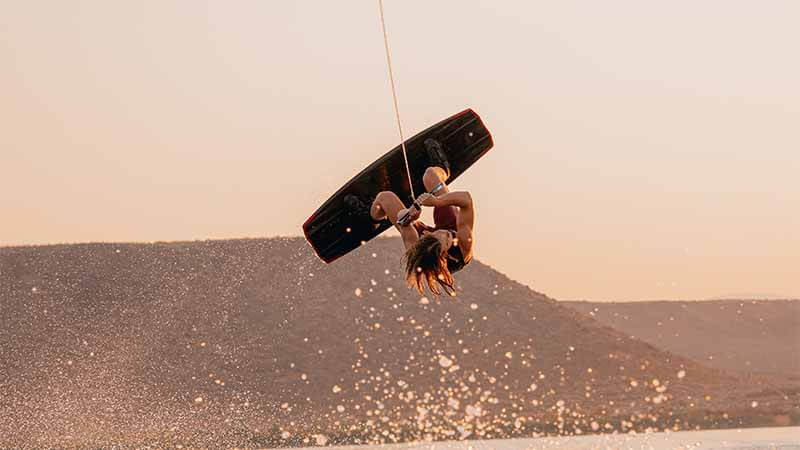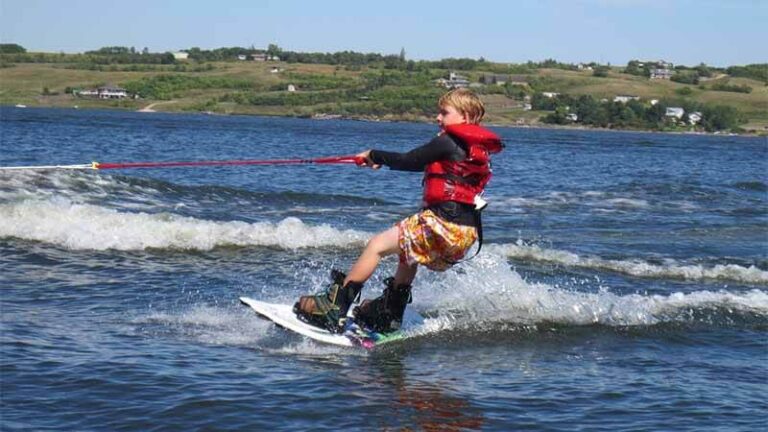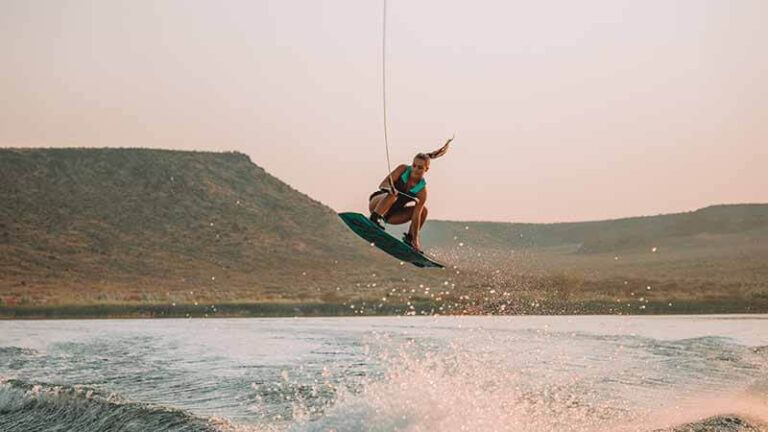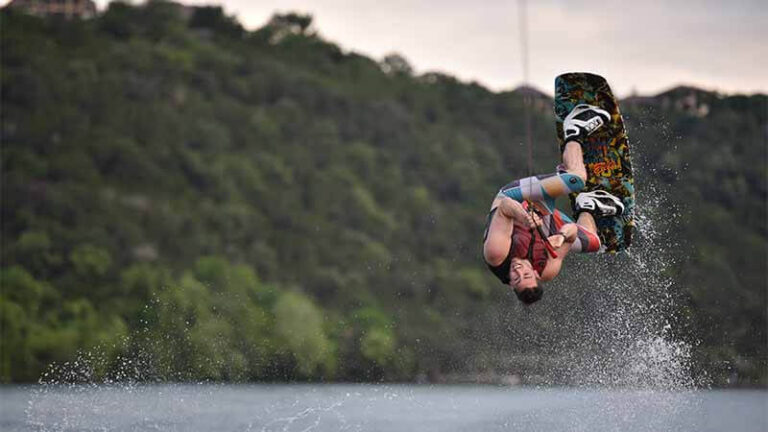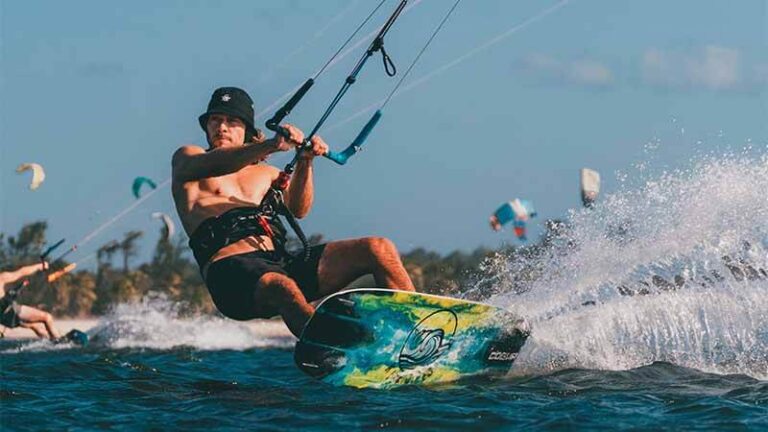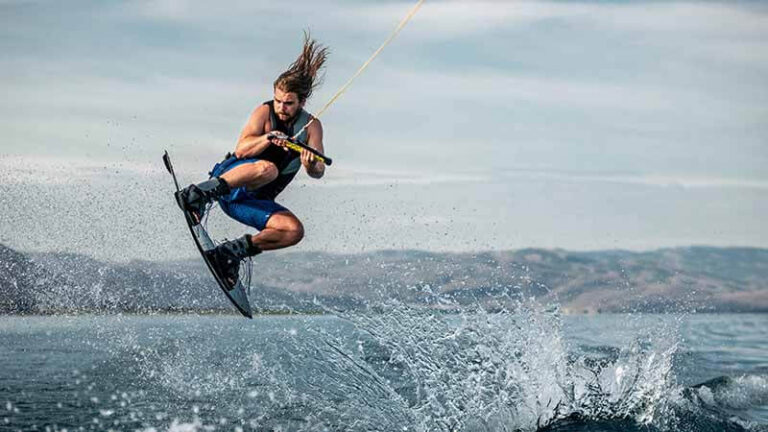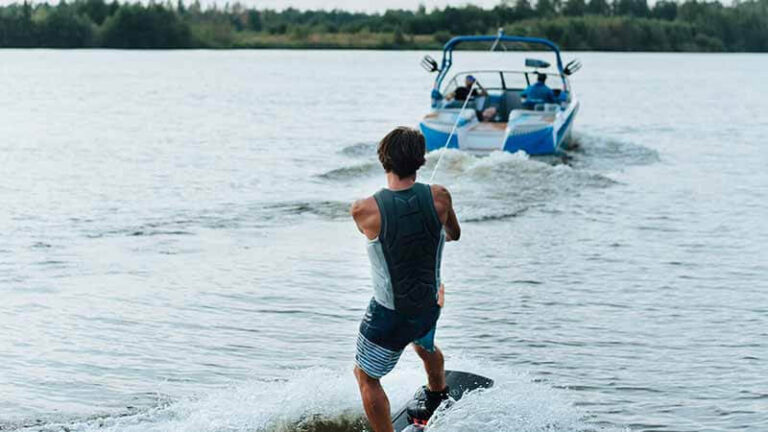How Wakeboard Rope Stretch Affects Your Ride
Wakeboard rope stretch refers to the elongation or deformation of a wakeboard rope caused by tension during a ride. As the rider is dragged by the boat’s speed, the rope is stressed and stretches to some extent. This stretching varies based on the material, manufacture, and general quality of the rope. In some situations, the rope may expand dramatically, negatively impacting the wakeboarder’s performance and experience on the water.
Importance of understanding rope stretch in wakeboarding
Understanding rope stretch is critical in wakeboarding for various reasons. To begin with, rope stretch has a direct impact on the rider’s control and maneuverability on the board. Excessive stretch in a rope can cause a delayed response to the rider’s actions, making it difficult to execute tricks and routines with precision.
Furthermore, higher rope stretch causes energy loss since the rope absorbs some of the rider’s momentum, resulting in slower speeds and potentially more difficulty attaining height during jumps.
Moreover, rope stretch has an effect on the wakeboarder’s overall stability and balance. Unpredictable rope stretching can generate unexpected jerks or slack, making it difficult for the rider to maintain good body positioning and stay on the board. Instability can increase the danger of falls and injuries, particularly during more advanced maneuvers.
This blog post’s major goal is to highlight the vital relevance of minimal rope stretch in wakeboarding. By emphasizing the implications of excessive rope stretch, the blog hopes to highlight the important role that wakeboard rope quality plays in improving overall riding experience and performance.
The blog will introduce readers to ropes that excel in reducing stretch and improving wakeboarding performance through in-depth analysis and reviews. Various rope materials, including Dyneema, Spectra, and Polyethylene, will be investigated, highlighting their distinct characteristics that lead to less stretch and increased control for wakeboarders.
Finally, the blog article aims to educate wakeboarding aficionados about the effects of rope stretch on their rides and provide them with the knowledge they need to make informed decisions when purchasing a wakeboard rope. Riders may improve their performance, complete stunts more easily, and ensure a safer, more fun wakeboarding experience overall by selecting the proper rope with minimal stretch capabilities.
Understanding Wakeboard Rope Stretch
Explanation of wakeboard rope construction
Wakeboard ropes are specifically developed and built to endure the rigors of wakeboarding. They usually have a core and an outer sheath. The core is the strength and load-bearing capability of the rope, while the sheath is a protective coating that protects the core from wear and tear. Braided or twisted fibers, such as polyethylene, Spectra, or Dyneema, are the most commonly utilized materials in wakeboard rope fabrication. These materials vary in strength, flexibility, and stretch resistance.
Wakeboard rope structure varies, with some ropes having a higher number of braided or twisted strands, resulting in improved strength and lower flexibility. To minimize elongation during use, high-quality ropes frequently contain modern technologies such as pre-stretching or low-stretch fibers. Understanding wakeboard rope construction is critical since it directly influences the rope’s stretch characteristics and, as a result, the rider’s experience on the lake.
Factors contributing to rope stretch during wakeboarding
A variety of factors contribute to rope stretch while wakeboarding. One important factor is the material used to make the rope. Stretch characteristics differ between materials, with some being more prone to elongation than others. Polyethylene ropes, for example, may have more stretch than Spectra or Dyneema ropes, which are known for their low-stretch characteristics.
The age and condition of the rope are other important considerations. Wakeboard ropes can degrade over time as they are subjected to constant stress and wear. Worn or damaged ropes may exhibit increased stretch, limiting the rider’s control and overall performance.
Furthermore, the amount of stretch is determined by the strain given to the rope while wakeboarding. Higher tension, such as when the rider performs aggressive maneuvers or jumps, might result in more elongation.
Understanding these characteristics enables wakeboarders to select ropes that best suit their riding style and preferences, while also being aware of how varied conditions might alter the rope’s performance.
How rope stretch impacts the rider’s experience and performance
The length of the rope has a direct impact on the rider’s enjoyment and performance during wakeboarding. Excessive rope stretch can cause a delayed reaction, making precise control of the board difficult. The rider may notice a lag in the rope’s reaction to their motions, which can make it difficult to execute tricks and routines with precision and timing.
Furthermore, increased rope stretch results in increased energy absorption and loss during the ride. As the rope lengthens, it absorbs some of the rider’s momentum, resulting in slower speeds and potentially restricting jump height. This energy loss can have a substantial impact on a wakeboarder’s ability to perform tricks at their peak, leading to dissatisfaction on the lake.
Moreover, rope stretch has an impact on the wakeboarder’s stability and balance. If the rope stretches in an unpredictable or uneven manner, it might introduce unexpected jerks or slack, causing the rider’s body alignment and balance to be disrupted. This instability can increase the possibility of falls and injuries, especially while performing more difficult routines or attempting to land tricks.
The Importance of Minimal Rope Stretch
Reduced energy loss and increased control
Minimal rope stretch is critical in wakeboarding since it directly affects the rider’s energy efficiency and board control. Excessive stretching of the wakeboard rope absorbs a considerable percentage of the rider’s velocity during acceleration and jumps.
As a result, the rider must use more energy to maintain speed and height, which leads to fatigue and decreased performance over time. However, with a rope that stretches little, energy loss is reduced, allowing the rider to maintain a higher speed and responsiveness throughout the ride.
Furthermore, less rope stretch improves the rider’s control of the wakeboard. A rope with less elongation responds more quickly and precisely to the rider’s motions, allowing for smooth transitions between tricks and maneuvers. Wakeboarders with enhanced control may execute spins, flips, and grabs with greater accuracy, exhibiting their skills to the utmost.
Impact on tricks and maneuvers
The importance of having as little rope stretch as possible on wakeboarding feats and moves cannot be stressed. Wakeboarders rely mainly on the tension in the rope to create lift and stability when performing aerial stunts or launching from the wake.
Excessive rope stretch might interfere with the timing and tension required for these maneuvers, making achieving the desired height and control during aerial stunts difficult.
Wakeboarders, on the other hand, benefit from a continuous and reliable pull from the boat due to less rope stretch. This steady tension is essential for doing tricks like backflips, 180s, and grabs because it lets the rider properly predict and time their moves.
Wakeboarders can create muscle memory for specific feats with less stretch, resulting in more confident and polished performances.
Enhanced stability and predictability
Wakeboarders rely greatly on stability and predictability to maintain balance and control during their rides. Rope stretch has a direct impact on the rider’s stability since unexpected elongation or slack in the rope can induce instability and fall.
A rope with little stretch provides a more steady and predictable connection between the rider and the boat, decreasing the possibility of unexpected movements that could throw the rider off balance.
Predictability is also essential while performing difficult stunts and moves. As they approach the wake or initiate a trick, wakeboarders must anticipate the tension and response from the rope.
A rope with little stretch provides a steady feel, allowing the rider to make exact changes and confidently execute tricks. Riders can better anticipate the rope’s behavior and plan their maneuvers as a result of this predictability.
Ropes That Excel in Reducing Stretch
Dyneema-based ropes
Dyneema-based ropes are well-known for their great strength and low stretch, making them a favorite choice among wakeboarders looking for superior performance on the water. Dyneema is a high-performance synthetic fiber that outperforms steel in terms of strength-to-weight ratio. This distinguishing feature enables Dyneema ropes to resist the tremendous tension and stress encountered during wakeboarding without compromising their integrity.
One of the primary benefits of Dyneema ropes is its low elongation rate, which ensures little stretch during rides. This less stretch leads to a more direct and rapid response to the rider’s actions, giving the rider more control over the wakeboard. Wakeboarders can execute tricks and leaps with accuracy thanks to the continuous tension produced by Dyneema ropes, enhancing their performance on the water.
Furthermore, Dyneema ropes have great abrasion resistance, ensuring longevity even in difficult water or uneven terrain. Because of their resistance to UV deterioration and water absorption, they are a dependable investment for wakeboarding enthusiasts searching for a rope that excels at decreasing stretch while keeping great strength.
Spectra ropes
Spectra ropes are another popular choice for wakeboarders looking for decreased stretch and high-performance characteristics. Spectra, like Dyneema, is a synthetic fiber with high strength and low elongation qualities. Wakeboarders can execute tricks and movements with more precision thanks to the responsiveness and fast feedback provided by Spectra ropes.
Spectra ropes have a noteworthy resistance to creep, a phenomenon in which ropes gradually stretch under constant tension. The limited creep of Spectra guarantees that the rope retains its original length and tension, allowing passengers to feel the steady pull from the boat throughout the voyage. This function is very useful for wakeboarders who perform difficult tricks and aerial movements.
Furthermore, Spectra ropes are lightweight, which contributes to the wakeboarder’s overall agility and maneuverability. Their low-stretch properties improve rider control and stability, allowing for smooth transitions and landings during tricks. Wakeboarders who value responsiveness and predictability in their rides frequently prefer Spectra ropes because of their excellent performance and dependable qualities.
Polyethylene (Poly) ropes
Durability and properties: Polyethylene (Poly) ropes are a less expensive option that nonetheless provides significant durability and stretch resistance. Poly ropes are primarily made of braided polyethylene strands, which give excellent strength and durability for wakeboarding applications.
Although not as low-stretch as Dyneema or Spectra ropes, Poly ropes outperform standard nylon ropes in terms of elongation reduction. They provide a stable and dependable connection between the rider and the boat, allowing wakeboarders to enjoy a smoother and more controlled ride.
Poly ropes are suitable for regular usage because of their endurance and resistance to abrasion, particularly in less violent wakeboarding techniques or for beginners who are still polishing their skills. While Poly ropes do not have the same level of minimal stretch as Dyneema or Spectra ropes, they are a cost-effective option for wakeboarders looking for a durable and dependable rope for their riding demands.
Read: Best Wakeboard Ropes
Tips for Choosing the Right Rope
Rider skill level and experience
It is critical to consider the rider’s skill level and experience while selecting the correct wakeboard rope. Beginner wakeboarders may benefit from ropes with a little more flexibility since they allow forgiveness and help to shorten the learning curve. Increased rope stretch can reduce the impact of abrupt movements and jerks, making beginners less likely to lose balance and fall.
Experienced wakeboarders who have perfected their skills and want to maximize performance, on the other hand, should use ropes with the least amount of stretch. Low-stretch ropes are more sensitive, letting advanced riders perform stunts and routines with greater precision and control. These ropes provide instant feedback to minor movements, allowing experienced wakeboarders to push their limits and create more dynamic rides.
Wakeboarding style and preferences
Individual techniques and preferences of wakeboarders also play an important influence in choosing the correct rope. Some riders prefer to ride aggressively, performing aerial stunts and high-intensity maneuvers. Low-stretch ropes like Dyneema or Spectra are perfect for these riders because they give the responsiveness and stability required for intricate stunts.
Others may prefer a more relaxed wakeboarding experience, focusing on cruising and having fun. In such circumstances, polyethylene ropes provide a cost-effective alternative to typical nylon ropes while still reducing elongation and providing a comfortable and sturdy connection to the boat.
Furthermore, the length of the rope might have an effect on wakeboarding style and preferences. Longer ropes allow riders to ride in greater arcs and farther out from the boat, whilst shorter ropes provide a tighter line for more aggressive movements close to the wake. Riders can choose a rope that complements their particular riding style and boosts their overall enjoyment on the water by evaluating their wakeboarding style and preferences.
Budget considerations
Budget is a realistic element that should not be disregarded when selecting the best wakeboard rope. Due to the complex materials and production procedures used in high-performance ropes constructed from Dyneema or Spectra fibers, they are more expensive. While they provide higher performance and less stretch, they may not be ideal for all budgets.
Wakeboarders on a tight budget can still get high-quality ropes composed of Polyethylene fibers. These ropes provide durability and reduced stretch at a lower cost, making them more accessible to a larger spectrum of riders. Wakeboarders must create a balance between their budget and the desired rope features to ensure they acquire the best selection for their needs.
Read: The Ultimate Guide to Choosing the Right Wakeboard Rope
Maintaining and Caring for Wakeboard Ropes
Proper storage to prevent unnecessary stretch
Proper storage is critical for preserving wakeboard ropes and avoiding undue stretch. It is critical to untangle the rope and eliminate any knots or twists after each wakeboarding session to guarantee even strain throughout the rope’s length. Coiling the rope neatly and avoiding sharp bends or kinks aids in the prevention of stress spots that can lead to premature wear and elongation.
It is also critical to keep the wakeboard rope away from direct sunshine and high temperatures. UV radiation and heat can weaken the fibers of the rope over time, increasing the chance of stretch and shortening its lifespan. A rope bag or storage container will shield the rope from these elements, preserving its performance and longevity.
Inspecting for wear and tear
It is critical to inspect the wakeboard rope on a regular basis for signs of wear and tear in order to spot potential problems early on. Examine the rope for frayed or damaged portions, loose strands, or any weakening of the core and sheath. Pay close attention to the connection points, such as the handle attachment and boat connection, as these are frequently stressed.
If severe damage or wear is discovered, the rope must be replaced immediately. Using a faulty rope might result in unexpected breakages, putting the rider and others on the water in danger. Regular rope inspections guarantee that wakeboarders can spot and treat any faults before they become serious, ensuring a safe and fun wakeboarding experience.
Tips for extending the rope’s lifespan
Wakeboarders can follow various recommendations and best practices to increase the longevity and performance of their wakeboard rope. Dragging the rope across surfaces such as docks or rugged terrains is an excellent approach to eliminate needless stress on the rope. Keeping the rope away from rough surfaces protects the outer sheath and ensures the structural integrity of the rope.
Another useful technique is to rotate the rope on a frequent basis while in use. Because wakeboarders frequently grip the handle in the same location during tricks and jump, the rope may acquire wear patterns at specific spots. Wakeboarders distribute wear evenly throughout the rope by turning the handle, extending its life, and preventing weak points.
Furthermore, after each usage, the wakeboard rope should be rinsed with fresh water, especially if it has been exposed to saltwater or dirt. Cleaning the rope removes any material or pollutants that could eventually cause abrasion or degradation. Furthermore, maintaining the rope in a cool, dry place away from sharp objects or chemicals extends its life.
Wakeboarders can extend the lifespan of their wakeboard rope, maintain optimal performance, and enjoy many successful and safe wakeboarding sessions by following these maintenance procedures and caring for their wakeboard rope meticulously.
Read: How to Properly Care for Your Wakeboard Rope
Conclusion
Finally, the importance of a high-quality wakeboard rope for overall performance and enjoyment of wakeboarding cannot be emphasized. We’ve talked about the importance of minimal rope stretch and how it affects a wakeboarder’s experience on the lake throughout this blog article. Low-stretch ropes, such as those constructed of Dyneema or Spectra fibers, provide unequaled benefits in terms of reduced energy loss, better control, and enhanced stability.
The correct wakeboard rope connects the rider to the boat directly, controlling the level of responsiveness and feedback during maneuvers. Wakeboarders with a high-quality rope have the confidence to push their talents to new heights, execute tricks with precision, and enjoy a smoother, more pleasurable ride. Purchasing a rope that reduces stretch is an investment in wakeboarding performance and overall advancement in the sport.
Wakeboarding fans must use caution while selecting a wakeboard rope. Individuals can choose a rope that meets their own needs and preferences by taking into account elements like rider skill level, wakeboarding style, and money. The appropriate rope can have a big impact on your wakeboarding experience, improving your control, stability, and performance on the lake.
When purchasing a wakeboard rope, we advise our readers to make an informed decision, opting for quality and durability to provide a safer and more fun riding experience. Remember that the benefits of a high-quality rope go beyond reduced stretch; it has a direct impact on the rider’s control, energy efficiency, and trick and maneuver execution.
So, before your next ride, review your present wakeboard rope and determine whether it corresponds with your wakeboarding aims and desires. Whether you’re a beginner looking for forgiveness or an accomplished rider aiming for peak performance, the appropriate rope may make or break your ride.
Invest in a proper wakeboard rope and go on a voyage of enhanced wakeboarding adventures as you glide easily across the water, confidently pushing your limits and experiencing the sport’s pleasure.

